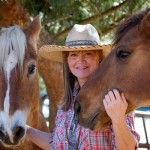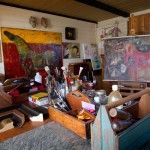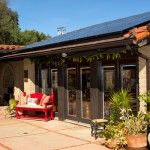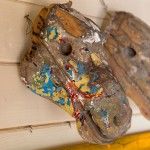Interview by Bonnie Gangelhoff, Photos by Sean Michael Haffey
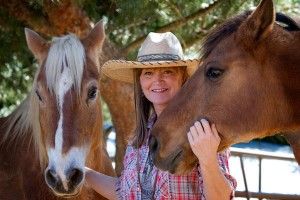 Describe your studio. The main house and some nearby buildings were built of adobe in the 1940s and then updated in the ’70s. When we bought the property, it had been abandoned for several years, so we started a complete restoration. My husband, Russ, took an existing adobe open-air structure, framed it in with French doors, and put in high north-light windows. We also added a solar-panel roof, so the studio generates all of the electricity for the property. I really value the realization of a solar adobe studio. I love the juxtaposition of the very new next to the very old. It’s a recurring theme in my work as well.
Describe your studio. The main house and some nearby buildings were built of adobe in the 1940s and then updated in the ’70s. When we bought the property, it had been abandoned for several years, so we started a complete restoration. My husband, Russ, took an existing adobe open-air structure, framed it in with French doors, and put in high north-light windows. We also added a solar-panel roof, so the studio generates all of the electricity for the property. I really value the realization of a solar adobe studio. I love the juxtaposition of the very new next to the very old. It’s a recurring theme in my work as well.
Is this studio different from your past studios? I’ve had studios that were also art retreats with books, reference material, and spaces to read and contemplate. For this studio, I specifically wanted it to be a place for painting only. My books are in the house, and I do most of my contemplation on the back of a horse. When I walk through the studio door, I know that I will be actively working and painting only.
What do you enjoy most about the studio? That everything I use is immediately at hand. Since I am an artist who uses other media in addition to traditional oil paint, I have a lot of materials that I need to access. Although it probably looks disorganized to someone else, the size and design of the workspace helps me know exactly where everything is. I usually work with all of the French doors and windows open, and I feel like I’m painting outdoors, which inspires and soothes me.
Describe your surroundings. The studio is situated on one of the highest points of our hillside property. The horses live just below, and I can hear them stomp while I work. The perimeter of the property has a fence line of prickly pear cactus. (There’s also a chain-link fence in there somewhere, but the cactus has grown so big, you can only see the chain-link in certain spots.) The land here has both a coastal and a desert climate. We have citrus trees mixed with succulents and tall coastal grasses. There are pine and eucalyptus trees, cacti, and rose gardens. I have walked out the studio door to be greeted by a lanky roadrunner. This place contains so much unexpected visual contrast. One of the major forces in my work is exploring the tension between the ordinary and the strange, and the environment here is a constant representation of that idea.
What animals do you have on the property? Three horses, two mules, and two burros. One mule is the sweetest in the world and is teaching our grandchildren how to ride. The other mule is the biggest in the world—a 1,600-pound draft mule. The burros keep us safe from coyotes. I’ve also taken them to schools as part of a living-history presentation, and they are happiest when they have little kids draped all over them. We also have two mutt ranch dogs, with only seven legs between them, and two useless house cats.
Why are you attracted to horses as subject matter? Horses have been a part of me from my earliest memories. There are parts of my relationship with horses that are explainable and traceable and other parts that aren’t. In the light of day, horses are fun and interesting. Some are affectionate and companionable; others are calculating or indifferent. They may bear you to a great adventure or to a tragic conclusion. By night, horses have often walked through my dreams, bigger than life, mysterious yet comforting. I’m not entirely sure why I am compelled to paint and repaint horses. I just follow my brush. I am always trying new ways to reveal the form. Occasionally I paint other things that interest me, but I always come back. In paint, my horses can sometimes do impossible things without being obvious about it. The most unexpected and inexplicable things happen, such as when your horse (or mule) has saved you out on the trail in an unexpected way, or when strange occurrences happen in the barn in times of difficulty.
How do you describe your style of work? Contemporary western. My work is deeply rooted in western ideas, and I express my western forms as a modernist painter. I am influenced by the figurative expressionists, and an important event in my art life was seeing a retrospective of Nathan Oliveira’s work in San Jose in the ’90s. It felt to me like he was finding some of the essence of being human.
What do you keep in your studio? I have a pair of very old, hand-carved carousel horse heads that have been in the studio with me for many, many years. I think they keep me honest. E
representation
McLarry Modern, Santa Fe, NM; www.sharronevansart.com.
Featured in April 2012.






